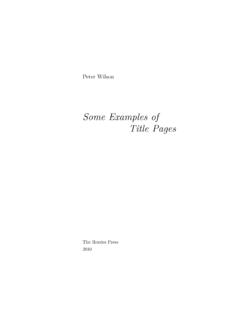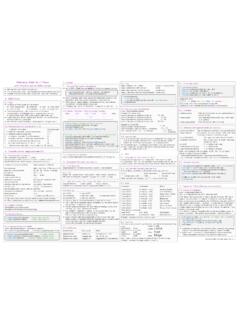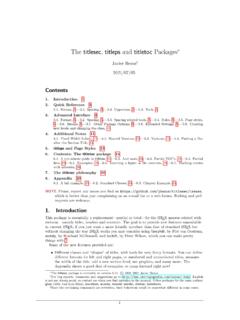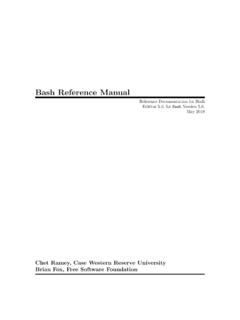Transcription of ChemFig - CTAN
1 Chemf ig 1 august 2021. Christian Tellechea A TEX package for drawing molecules HO O OH. OH CH3. CH3. O. CH3. HN O CH3. O. O O. O O. OH. O O. CH3. Taxotere .. OH OH2 R .. N C R. OH2 OH O. N N H . H H2 O H2 O.. R R R .. R . N C R N R N R N R. R R R R H. The Beckmann rearrangement Contents I Introduction 4. 1 New in 4. Lewis decorations .. 4. Key debug .. 4. Token # in schemes .. 4. 2 Presenting ChemFig 4. 3 Acknowledgment 5. II Operation of ChemFig 6. 1 The \ ChemFig macro 6. 2 Groups of atoms 7. 3 First atom's role 7. 4 Different types of bonds 7. 5 Bond angle 9. Predefined angles .. 9. Absolute angles .. 10. Relative angles .. 10. 6 Length of a bond 10. 7 Departure and arrival atoms 11. 8 Customization of bonds 12. 9 Default values 12. 10 Branches 13. Principle .. 13. Nesting .. 14. Method .. 14. 11 Connecting distant atoms 15. 12 Rings 16. Syntax .. 16. Angular position.
2 17. At the start .. 17. After a bond .. 18. Branches on a ring .. 18. Nested rings .. 19. Rings and groups of atoms .. 20. Center of rings .. 20. 13 Representing electron movements 21. Mesomeric effects .. 21. Reaction mechanisms .. 23. 14 Writing a name under a molecule 23. Compiled the August 1, 2021. 1. III Advanced usage 26. 1 Separating atoms 26. 2 Displaying atoms 26. 3 Arguments given to tikz 27. 4 Shifted double bonds 27. 5 Delocalized double bonds 28. 6 Saving a sub-molecule 28. 7 Placement of Atoms 30. First Atom .. 30. Groups of atoms .. 30. Bonds between atoms .. 31. La macro \chemskipalign .. 32. 8 The macro \charge 33. Overview .. 33. Parameters .. 33. Lewis formula .. 34. Integration in ChemFig .. 35. 9 Stacking 35. 10 Using \ ChemFig in the tikzpicture environment 36. 11 Annotated examples 36. Ethanal .. 36. 2-amino-4-oxohexanoic acid .. 37. Absolute angles.
3 37. Relative angles .. 37. Ring .. 37. Nested rings .. 38. Glucose .. 38. Skeleton diagram .. 38. Fisher projection .. 39. Chair representation .. 40. Haworth projection .. 40. Adrenaline .. 41. Using one ring .. 41. Using two rings .. 42. Guanine .. 42. 12 How to .. 44. Write a colored atom .. 44. Add a superscript without modifying a bond .. 44. Draw a curve bond .. 45. Draw a polymer element .. 45. Draw the symmetrical of a molecule .. 47. Add text above bonds and arc to angles .. 47. Dessiner des liaisons multiples .. 48. IV Reaction schemes 48. 1 Overview 49. Compiled the August 1, 2021. 2. 2 Arrow types 49. 3 Arrows features 50. 4 Compounds names 51. 5 Anchoring 51. 6 Compounds style 53. 7 Branching 53. 8 Subscheme 54. 9 Arrows optional arguments 57. 10 Arrows customization 59. First arrow .. 59. Curved arrow .. 60. 11 The \merge command 61. 12 The + sign 63.
4 V List of commands 66. VI Gallery 68. Compiled the August 1, 2021. 3. Introduction 1 New in Lewis decorations As announced since version of 5/3/2020, the deprecated macros lewis and Lewis are no longer available in the ChemFig package. The recommended method for drawing Lewis formulas is to use \charge and \Charge, see page 33. If the use of the macros lewis and Lewis is indispensable, their code is in the file which it is possible to load using input, after having loaded the package ChemFig . Key debug A new boolean key debug, false by default, is available. When set to true, the (rectangular) outline of each group of atoms is drawn in red and the outline of each atom is drawn in gray. The number of the group of atoms is shown above the red rectangle, and similarly for the number of each atom (the atoms are numbered from left to right, starting from 1). These numbers allow to know the name of the node of each atom whose syntax is n<a>-<b> where <a> is the number of the atom group and <b> is the number of the atom.
5 In this example, a blue arrow starts at atom n1-3, which is "C2", and goes to atom n2-4, which is "Gz". Name of nodes \setchemfig{debug=true} 2 3. DxEyFGz H3I. \ ChemFig {A1BC2-[:30]DxEyFGz-H3I} 1 1 2 3 4 1 2. \chemmove{\draw[blue](n1-3)to[out=75,in= 90](n2-4);} A1BC2. 1 2 3. Token # in schemes In a scheme, the # token is now allowed when in the argument of the \ ChemFig macro . See page 8. 2 Presenting ChemFig To use this package, start by adding the following code to the preamble: \input with TEX;. \usepackage{ ChemFig } with LATEX;. In all cases, the tikz package, if not loaded before, is loaded by ChemFig . The most important command for drawing molecules is \ ChemFig { code }. The argument code is a set of characters describing the structure of the molecule according to the rules which are described in this manual. Care has been taken to make it possible to draw the greatest possible number of molecular configurations, while maintaining a simple, flexible, and intuitive syntax.
6 Despite this, the code which describes the 2D structure of the molecule increases in complexity in proportion to that of the molecule being drawn. The command \ ChemFig draws a molecule using the commands provided by the tikz package, placed inside a tikzpicture environment. The choice of tikz implies that: Compiled the August 1, 2021. 4. the user has a choice of compilation method: pdfLATEX can be used equally well in dvi mode (tex . dvi ps pdf) or in pdf mode (tex pdf). In effect tikz, via the underlying pgf, gives identical graphical results in the two modes;. the bounding box is automatically calculated by tikz and the user need not worry about any overlap with the text. However, care must be taken with alignment when the molecule is drawn in a paragraph. In the O. following example, we have drawn the bounding box for the molecule: H3 C C . OH. 3 Acknowledgment This package has seen the light of day thanks to the assistance of Christophe Casseau, who had the idea.
7 I thank him for his help before writing the code and for the tests he carried out. I also want to warmly thank Theo Hopman for offering to translate this manual into English. Compiled the August 1, 2021. 5. Operation of ChemFig This part is devoted to describing the most common features of ChemFig . The user will find here explanations sufficient to draw most molecules. The presentation of features is done from a theoretical angle, and the goal of this part is not to draw real molecules but to give the user a formal description of the functionality of ChemFig . The Advanced usage , page 26, will be more practical and will illustrate advanced features for the most demanding uses. It will also highlight methods of building real molecules, page 36. Finally, the last part will give examples of molecules and the code used to draw them. 1 The \ ChemFig macro The macro \ ChemFig has the following syntax \ ChemFig [list of keys = values ]{ molecule code }.
8 The optional argument in square brackets sets the parameters used for this molecule. It should be noted that the parameters are only modified for the current molecule and will be restored to their previous values after the macro has been executed. To permanently modify parameters, the macro \setchemfig{ key = values } should be used. Here is the complete list of parameters as well as their default values. It should be noted that the keys from scheme debug included to the end of the list concern reaction schemes and make no sense in the optional argument of the macro \chefig where they are simply ignored: keys default values keys default values . ChemFig style empty scheme debug false atom style empty compound style empty . bond join false compound sep 5em fixed length false arrow offset 1em cram rectangle false arrow angle 0. cram width arrow coeff 1. cram dash width 1pt arrow style empty.
9 Cram dash sep 2pt arrow double sep 2pt atom sep 3em arrow double coeff bond offset 2pt arrow double harpoon true double bond sep 2pt arrow label sep 3pt angle increment 45 arrow head -CF. node style empty + sep left bond style empty + sep right debug false + vshift 0pt cycle radius coeff stack sep show cntcycle false autoreset cntcycle true The molecule code contains instructions for drawing the molecule according to a syntax that will be explained in this document. There are no restrictions on the characters accepted in the code: all catcode 11 or 12 characters, i. e. upper and lower-case letters, numbers, mathematical operators (+ - * /. =), punctuation marks whether active or not (. , ; : ! ? ' " |), parenthesis and brackets;. Compiled the August 1, 2021. 6. more special characters such as "~", "#"1 as well as "^" and "_" which have their normal mathematical mode properties.
10 Spaces, but these are ignored by default because the atoms are composed in mathematical mode;. the "{" and "}" braces that have their normal behavior as group markers or macro argument delimiters;. macros. 2 Groups of atoms Drawing a molecule consists inherently of connecting groups of atoms with lines. Thus, in the molecule O O, there are two groups of atoms, each consisting of a single atom O . However, in this molecule O. H3 C C. OH. there are four groups of atoms: H3 C , C , O and OH . For reasons which we shall see later, ChemFig splits each group into single atoms. Each atom extends up to the next capital letter or one of these special characters: - = ~ ( ! * < > @ . ChemFig ignores all characters inside braces when splitting groups into atoms. Therefore the first group of atoms H3 C is split into two atoms: H3 and C . In terms of chemistry, of course, these are not real atoms; H3 , for example, consists of three hydrogen atoms.)













